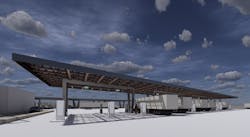WattEV Plans 25-MW Electric Truck Stop Microgrid
Startup company WattEV plans to build a first-of-its-kind, 25-MW microgrid in Bakersfield, California, that would host chargers for electric trucks.
“Having it as a microgrid with its own solar generation and battery storage is key to being able to have a stable supply of affordable high-power electricity for the chargers,” said Salim Youssefzadeh, WattEV chief executive officer, noting it will be grid-connected as a backup.
Photo courtesy of WattEV
The project is designed to support electric truck transport between California’s Central Valley and Southern California’s ports and shipping hubs, according to the company.
The 110-acre truck stop near fulfillment centers run by Amazon and Walmart will be powered by solar panels plus battery storage. It would also get power from Pacific Gas & Electric, WattEV said earlier this month.
The company plans to start the microgrid at 4 MW and grow it to 25 MW with more than 40 charging bays.
Partners in the project include the San Joaquin Valley Air Pollution Control District; Greenlots, a charging company owned by Shell; Power Electronics, a solar company; the Central California Asthma Collaborative; and heavy-duty truck makers, according to WattEV.
Youssefzadeh didn’t want to discuss the exact roles the partners will play until the state approves the project.
The project will largely be financed by WattEV’s private backers, according to Youssefzadeh.
In a sign of the project’s viability, the California Energy Commission has recommended the project receive a $4 million grant out of $21.5 million being offered by the agency for medium- and heavy-duty fleet electrification. WattEV would have to match the grant with $2.3 million of its own money.
What’s the best way to pay for your microgrid? Find out this week at Microgrid 2021 in special sessions devoted to the economics of microgrids on May 18 and 20.
Trucks-as-a-service model
WattEV, based in El Segundo, California, said it is adopting a “trucks-as-a-service” business model and has put in an order for 50 Tesla trucks and plans to order more electric trucks from other truck makers. WattEV would essentially rent out the vehicles as they are needed by trucking companies.
The model aims to help small fleets and owner-operators overcome the high upfront costs of both the electric trucks and their charging infrastructure, according to Youssefzadeh.
“We aim to enable the addition of 12,000 heavy-duty battery electric trucks to the roads in California by the end of 2030,” Youssefzadeh said. “Our aim is to fast-track the transition to electric truck transport.”
WattEV aims to break ground later this year so the facility is ready when the first trucks are delivered in 2022, according to Youssefzadeh.
California intends to shift its cars and light trucks to all electric sales by 2035. The Air Resources Board approved a rule last year that requires medium- and heavy-duty truck sales to begin in 2024 and ramp up to all electric by 2045.
Behind-the-meter distributed resources, such as solar, for charging can help California meet its greenhouse gas emission reduction goals, the agency said in a presentation on its grant funding for truck electrification.
Track news about microgrids and electrification by subscribing to the free Microgrid Knowledge Newsletter.
